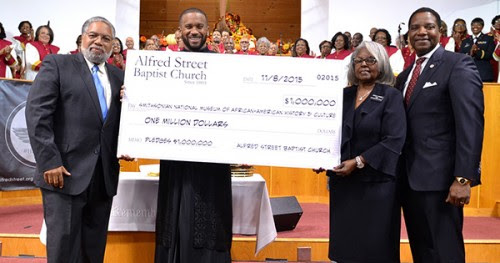
Lonnie G. Bunch III, the founding director of the Smithsonian National Museum of African American History and Culture (NMAAHC), was appointed the new Secretary of the Smithsonian on Tuesday. According to dcist.com, Bunch is the fourteenth person to hold the position in the Smithsonian’s 173-year history, and the first African American.
As Secretary, Bunch will manage the administration of the Smithsonian’s 19 museums, 21 libraries, and the National Zoo. He is also responsible for its $1.5 billion annual budget. Bunch succeeds David J. Skorton, who announced his resignation in December.
“Lonnie has spent 29 years of his life dedicated to the Smithsonian, so he knows the institution inside and out,” said David Rubenstein, the chair of the Smithsonian Board of Regents on Tuesday. The Board met at the Supreme Court earlier in the day unanimously elected Bunch as Secretary.
“He’s also highly regarded by members of Congress and highly respected by our donor base,” Rubenstein added, while also citing Bunch’s “incredible character” and his leadership of the NMAAHC as major assets.
“You’re going to make a historian cry,” Bunch said when he spoke at Tuesday’s press conference. “This is an emotional moment, because the Smithsonian means so much to me personally and professionally.”
Bunch was the first curator for the California African American Museum in Los Angeles in the 1980s and previously served as president and director of the Chicago History Museum from 2000 to 2005. In 2005, Bunch came to the Smithsonian to steward NMAAHC from conception. He shepherded both the David Adjaye-designed structure, did tireless fundraising, and helped build up and curate the museum’s collection from scratch.
The museum has been such a huge success that tickets are still largely required more than two years after opening, with visitors staying for hours longer than at other facilities. In its first year of operation, NMAAHC welcomed nearly 2.4 million visitors and was the fourth-most visited Smithsonian institution.
“It tells the unvarnished truth,” Bunch told DCist on the one-year anniversary of the museum’s opening. “I think there are people who were stunned that a federal institution could tell the story with complexity, with truth, with tragedy, and sometimes resilience.”
Over his tenure, Bunch and his team of curators made it a point to continue building a collection for the museum’s future, including acquiring artifacts from the Black Lives Matter movement, and to integrate D.C.’s own rich history into the fabric of the museum.













